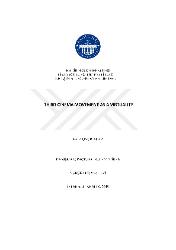Third cinema movement as a virtuality
Özet
The struggle against capitalism was gaining power in the 1960s, both in Europe and in Latin America, and cinema was considered as one of the fields of conflict by the activists. In this context, Fernando Ezequel Solanas and Octavio Getino created the Third Cinema Movement as a strategy to revolutionize the cinema as a form that attracted the masses to the struggle. They declared in their manifesto (Towards a Third Cinema, 1968) that one of the most important objectives of the Third Cinema Movement was to produce revolutionary subjectivities. In this thesis, I argue that the Third Cinema Movement's understanding of cinema and their suggestions are still effectual. In this regard, first the theory (manifest) of the movement is read on the basis of the studies of Maurizio Lazzarato Gilles Deleuze. Then, the mechanism of capitalism today, namely, that of the Post-Fordist era, is analyzed to re-establish the material basis of the arguments of the Third Cinema Movement. Meanwhile, the increasing importance of the production of subjectivities in the Post-Fordist era is mentioned. Finally, on this basis, after summarizing the Deleuzian understanding of cinema, the movies that contain the main characteristics of the Third Cinema Movement are analyzed respectively: The Man with a Movie Camera (Dziga Vertov, 1928), The Battle of Chile (Patricio Guzman, 1975) and The Hour of the Furnaces (Fernando Solanas and Octavio Getino, 1968).These analyses are made mainly with the guidance of Deleuzian concepts such as "movement-image", "time-image" and "affect". In this context, it is demonstrated that the Third Cinema Movement has evaluated cinema and the audiences as well as history, even the universe, both as actuality and virtuality and that therefore, the production of subjectivities was carried out on this basis. 1960'lı yıllarda Avrupa'da olduğu kadar Latin Amerika'da da kapitalist sisteme karşı mücadele güç kazanıyordu. Aktivistler tarafından sinema mücadele alanlarından biri olarak kabul ediliyordu. Bu bağlamda, Fernando Ezequiel Solanas ve Octavio Gettino, sinemayı devrimci hale getirmenin, sinema aracılığıyla kitleleri mücadeleye çekmenin bir biçimi olarak Üçüncü Sinema Hareketi'ni ortaya çıkardılar. Solanas ve Getino, yayımladıkları manifestoda (Towards a Third Cinema, 1968) Üçüncü Sinema Hareketi'nin en önemli hedeflerinden birinin devrimci öznellikler yaratmak olduğunu belirttiler. Ben bu tezde, Üçüncü Sinema Hareketi'nin sinema anlayışının ve iddialarının bugünde etkisini koruduğunu iddia ediyorum. Bu bağlamda, öncelikle hareketin teorisi (manifestosu), Maurizio Lazzarato'nun ve Gilles Deleuze'ün çalışmalarından yararlanılarak yorumlanmıştır. Ardından, hareketin maddi zemini yeniden tesis edilmesi için günümüzde yani Post-Fordist dönemde kapitalizmin işleyişi analiz edilmiştir. Bu analizde, Post-Fordist dönemde öznellik üretiminin her geçen gün artan önemine dikkat çekilmiştir. Son olarak, bu temelde, Deleuzcü sinema anlayışı özetlendikten sonra Üçüncü Sinema Hareketi'nin temel özelliklerini barındıran üç film sırasıyla incelenmiştir; The Man with a Movie Camera (Dziga Vertov, 1928), The Battle of Chile (Patricio Guzman, 1975) ve The Hour of the Furnaces (Fernando Solanas and Octavio Getino, 1968). Bu incelemeler ağırlıklı olarak "hareket-imge", "zaman-imge" ve "duygulanım" gibi Deleuzcü kavramların yol göstericiliğinde yapılmıştır. Üçüncü Sinema Hareketi'nin sinemayı ve alıcılarını olduğu kadar tarihi ve hatta evrenin kendisini de hem aktüellik hem de virtüellik olarak da ele aldığı dolayısıyla öznellik üretiminin de bu temelde gerçekleştirildiği gösterilmiştir.
Koleksiyonlar
- Tez Koleksiyonu [1348]
















